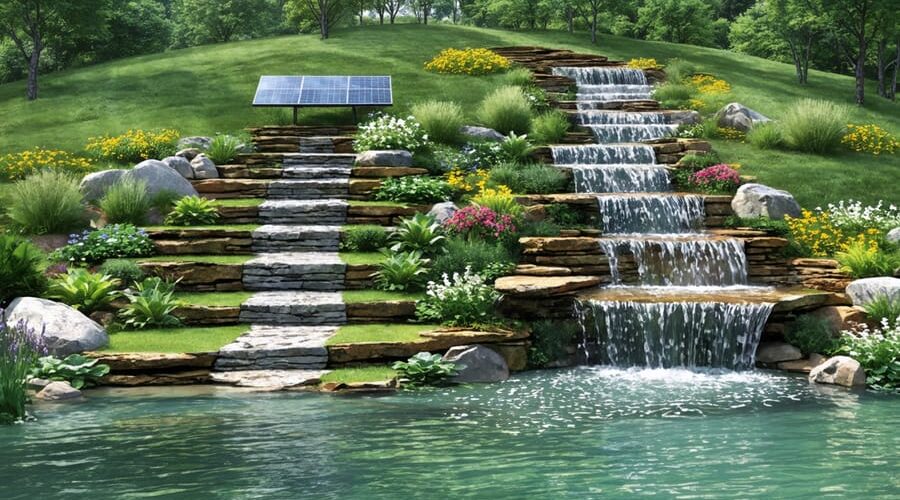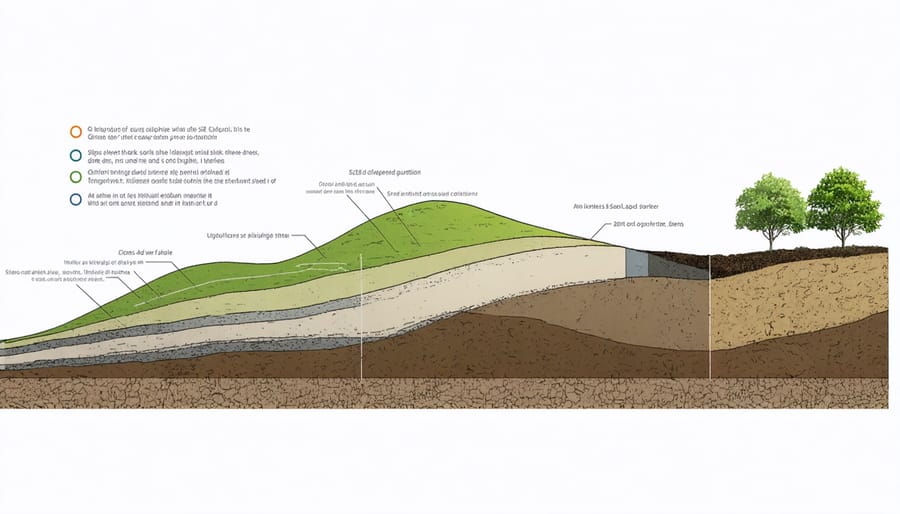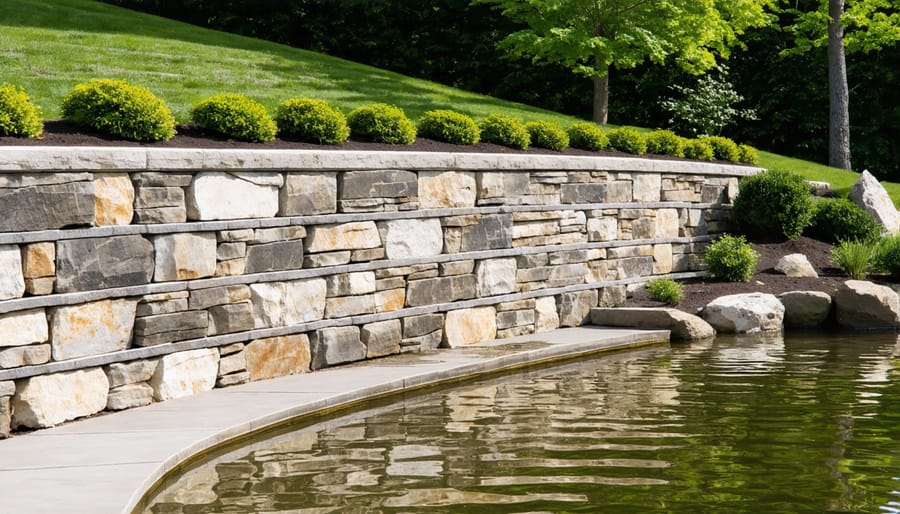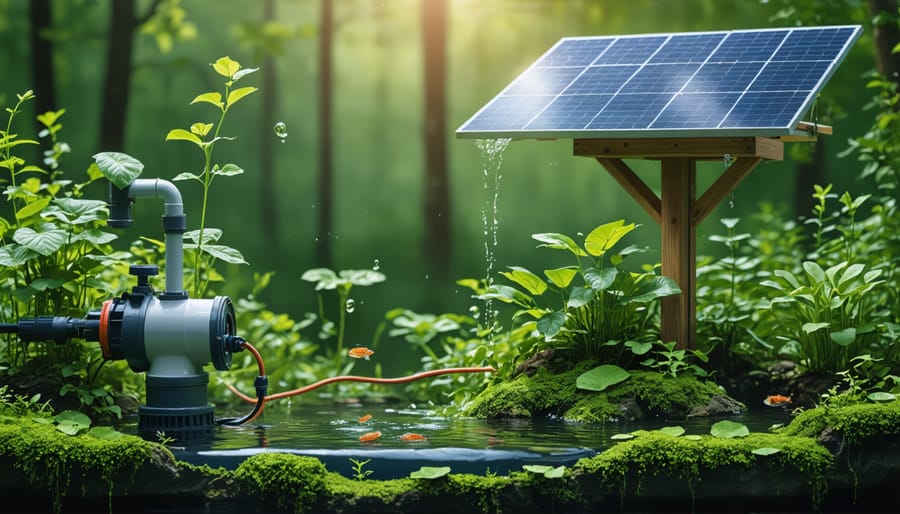
Build Your Dream Hillside Pond Without Harming the Environment
Transform your hillside into a stunning water feature by mastering the art of sustainable pond construction. Building a pond on sloped terrain demands careful planning and precise execution, but the rewards are extraordinary – creating a natural-looking waterfall, establishing diverse ecosystems, and adding significant value to your property.
Before breaking ground, analyze your hillside’s natural contours and soil composition. The slope’s grade determines your pond’s design, with gentle slopes (15-30 degrees) offering the most versatile options for construction. Steeper terrain requires additional reinforcement and specialized water management techniques, but can result in spectacular multi-level designs.
Smart material selection drives successful hillside pond construction. Opt for environmentally friendly liners like EPDM rubber or reinforced polyethylene, which conform naturally to terrain variations while providing decades of reliable service. Incorporate local stone for retaining walls and edge treatments, creating a seamless blend with the surrounding landscape while ensuring structural integrity.
The key to lasting stability lies in proper excavation and comprehensive drainage planning. Build your pond in stages, working from the bottom up, while implementing multiple overflow systems to handle heavy rainfall. This methodical approach prevents erosion and maintains water quality, establishing a self-sustaining aquatic environment that enhances your property’s natural beauty.
Evaluating Your Hillside Site

Soil Testing and Stability
Before breaking ground on your hillside pond, it’s crucial to understand your soil’s composition and ensure proper slope stability. Start by collecting soil samples from various depths and locations across your planned pond site. A simple jar test can give you a good indication of your soil composition: mix soil with water in a clear jar, shake well, and let it settle. Clay will form the top layer, silt in the middle, and sand at the bottom.
For a more thorough assessment, consider hiring a professional soil testing service. They can evaluate important factors like soil density, drainage capacity, and clay content. Clay-rich soils are ideal for pond construction as they naturally retain water, while sandy soils might require additional liner protection.
Test the soil’s stability by checking for signs of erosion or previous landslides. During wet seasons, observe how water moves across your hillside. If you notice water collecting in specific areas or soil movement, you’ll need to address these issues before construction begins. A good rule of thumb is to avoid slopes steeper than 3:1 (horizontal to vertical ratio) for optimal pond stability.
Natural Water Sources
Before starting your hillside pond project, take time to observe and understand the natural water flow on your property. Look for existing springs, seeps, or natural drainage paths that could feed your pond. These natural water sources can significantly reduce the need for artificial filling and help create a more sustainable water feature.
During rainfall, watch how water moves across your hillside. Areas where water naturally collects or channels form are ideal spots for pond placement. You might notice small streams forming or places where the ground stays damp longer than surrounding areas – these are valuable indicators of natural drainage patterns.
Consider conducting a simple percolation test by digging a small hole and filling it with water. How quickly the water drains will tell you about your soil’s ability to retain water. Clay-rich soils hold water better, while sandy soils might require additional liner material.
Remember that natural springs can vary seasonally, so observe your potential water sources throughout the year if possible. This helps ensure your pond will have a reliable water supply during drier months.
Eco-Friendly Liner Options
Natural Clay Liners
Natural clay liners offer an eco-friendly and cost-effective solution for waterproofing your hillside pond. When properly installed, they create a reliable barrier that prevents water seepage while maintaining a natural appearance that blends seamlessly with the surrounding landscape.
The key advantage of using natural clay is its self-healing properties. Small cracks or damage tend to seal themselves over time as the clay particles naturally bind together. Clay liners are also incredibly durable, often lasting decades with minimal maintenance, and they’re completely safe for fish and aquatic plants.
To install a natural clay liner, start by removing all rocks and sharp objects from the excavated pond area. The clay layer should be at least 8-12 inches thick when compacted. Apply the clay in 2-3 inch layers, thoroughly moistening each layer before compacting it with a mechanical compactor or hand tamper. Pay special attention to the edges and corners, as these areas are most prone to leakage.
For hillside applications, it’s crucial to ensure the clay extends well beyond the pond’s edges to prevent water from seeping underneath. Consider incorporating bentonite clay, which expands when wet, for additional sealing properties. While installation requires more physical labor than synthetic liners, the long-term benefits and natural aesthetics make clay liners an excellent choice for hillside ponds.
Recycled EPDM and PVC Options
When it comes to eco-friendly pond liner options, recycled EPDM and PVC materials offer excellent alternatives to new synthetic liners. These recycled materials often come from old roofing membranes and industrial applications, giving them a second life in your garden while maintaining the same durability and water-retention properties as new liners.
Recycled EPDM rubber is particularly well-suited for hillside ponds because of its exceptional flexibility and ability to conform to uneven terrain. It’s also UV-resistant and can last up to 20 years when properly installed. Many suppliers now offer EPDM liners made from up to 40% recycled materials, significantly reducing their environmental impact.
Recycled PVC liners are another eco-conscious choice, though slightly less flexible than EPDM. These liners are often manufactured from repurposed industrial materials and can be found in various thicknesses. While choosing recycled PVC, look for certifications that guarantee the material’s quality and safety for aquatic life.
Both options are typically more cost-effective than new liners while being just as reliable. When purchasing recycled liners, always verify the material’s thickness and ask about its previous use to ensure it’s appropriate for pond construction. Many suppliers also offer warranties on recycled materials, providing additional peace of mind for your sustainable pond project.
To properly install these recycled liners, treat them exactly as you would new materials, using appropriate underlayment and ensuring careful seam sealing when necessary.
Sustainable Retaining Walls
Natural Stone Solutions
Natural stone offers both beauty and functionality in hillside pond construction, and using local materials reduces your environmental footprint while creating a seamless blend with the surrounding landscape. When selecting stones, look for those native to your area – they’ll not only look more natural but also typically cost less due to reduced transportation needs.
For the best results, choose a mix of stone sizes. Large foundation stones provide stability for your pond’s walls, while smaller stones work perfectly for detailed edges and decorative features. Remember to source stones with at least one flat side, as these will stack more securely and create stable retaining walls.
When it comes to mortar, eco-friendly options are increasingly available. Consider using hydraulic lime mortar, which allows better water drainage and has a lower carbon footprint than traditional cement. For a truly sustainable approach, some natural clay-based mortars work well in less structurally demanding areas of your pond.
Layer your stones carefully, starting with the largest at the bottom. Place each stone so it tilts slightly inward toward the hill – this creates better structural integrity. Fill gaps between larger stones with smaller ones, known as “chinking,” to prevent soil erosion and create natural-looking crevices where beneficial plants can take root.
For the pond’s edge, use flat stones that overhang slightly, creating natural-looking shelves and hiding your liner while providing safe access for wildlife.

Reclaimed Materials
Giving your hillside pond a sustainable touch doesn’t have to break the bank. Reclaimed materials not only reduce environmental impact but can add unique character to your water feature. Broken concrete pieces, often called “urbanite,” make excellent retaining walls and provide natural-looking edges for your pond. Look for clean concrete without rebar or contaminants, and arrange the pieces like a puzzle to create sturdy walls.
Old timber can be repurposed for various pond elements, from steps leading down to the water to decorative borders. Cedar and redwood are particularly suitable due to their natural resistance to decay. Before using any reclaimed wood, ensure it hasn’t been treated with harmful chemicals that could leach into your pond water.
Railway ties and telephone poles should be avoided as they typically contain creosote and other toxic preservatives. Instead, look for natural logs from fallen trees or untreated lumber from demolition sites. These materials can be used to create viewing platforms or stabilize soil on the hillside.
When incorporating reclaimed materials, proper preparation is crucial. Clean concrete thoroughly and remove any loose debris. For wood, sand down rough edges and apply an eco-friendly sealant if needed. Remember to maintain the natural aesthetic by mixing different materials and allowing moss and plants to grow between concrete pieces, creating a seamless blend with the surrounding landscape.
Filtration and Circulation

Solar-Powered Systems
Solar-powered systems are an excellent eco-friendly choice for hillside ponds, offering both energy efficiency and flexibility in placement. A solar pump system typically includes solar panels, a pump, and sometimes a battery backup for cloudy days. These systems work particularly well in hillside settings, as the elevated position often provides excellent sun exposure.
When selecting a solar pump, consider your pond’s size and the height difference between the water source and its destination (head height). For most hillside ponds, a 20-50 watt solar pump can adequately circulate water through filters and create gentle waterfalls. The panels should be mounted facing south at approximately a 30-45 degree angle for optimal sun exposure.
Solar-powered filters are also available and work seamlessly with pump systems. These units are self-contained and require minimal maintenance. The best part? Your operating costs are virtually zero after initial installation, and you won’t need to worry about running electrical lines up your hillside.
For added reliability, consider installing a hybrid system with a small battery backup. This ensures your pond’s ecosystem stays healthy even during periods of limited sunlight.
Natural Biological Filtration
Creating a natural filtration zone in your hillside pond not only enhances its beauty but also maintains water quality through eco-friendly methods. Start by establishing a dedicated plant filtration area at the pond’s highest point, where water enters the system. This arrangement allows gravity to work in your favor, creating effective filtration systems that require minimal maintenance.
Layer your filtration zone with different-sized rocks, starting with larger stones at the bottom and progressively smaller ones toward the top. Plant water-loving species like cattails, rushes, and iris in this area – their roots naturally filter pollutants and excess nutrients from the water. Create shallow shelves or terraces within this zone to support various plant types at different depths.
Consider adding submerged plants like hornwort or water lilies in deeper areas, as they help oxygenate the water and compete with algae for nutrients. Position bog plants along the edges to create a seamless transition between your pond and the surrounding landscape while providing additional filtering benefits. This natural approach not only cleans your water but also creates valuable habitat for beneficial wildlife.
Maintenance and Long-Term Sustainability
Regular maintenance is key to ensuring your hillside pond remains a thriving ecosystem while preventing potential issues down the line. Following proper pond maintenance guidelines will help protect your investment and keep your water feature looking beautiful for years to come.
Monitor water levels regularly, especially during dry spells, and top up when needed using collected rainwater when possible. Check the pond’s structural integrity each season, paying special attention to any signs of erosion or settling around the edges. Address these issues promptly to prevent more serious problems from developing.
Keep the pond’s ecosystem balanced by regularly removing fallen leaves and debris, which can affect water quality and oxygen levels. Install a leaf net during autumn to make this task easier. Maintain aquatic plants by trimming dead foliage and dividing them when they become overcrowded.
For long-term sustainability, consider installing a solar-powered pump and filtration system. This reduces energy consumption while keeping your pond healthy. Create a buffer zone of native plants around the pond to prevent soil erosion and filter runoff naturally.
Test water quality monthly and adjust as needed, using eco-friendly treatments when necessary. In winter, use a floating de-icer to maintain a small opening in the ice for gas exchange, rather than breaking the ice manually, which can stress fish and damage the liner.
Remember that a well-maintained hillside pond not only enhances your property but also provides valuable habitat for local wildlife. Regular care ensures your pond remains an environmentally friendly feature that brings joy for years to come.
Building a hillside pond is an exciting project that can transform your landscape while working harmoniously with nature. By following proper construction techniques and incorporating sustainable materials, you can create a beautiful water feature that will thrive for years to come. Remember to thoroughly assess your site, implement proper drainage systems, and use appropriate liner materials to ensure your pond’s stability on the slope.
The key to success lies in careful planning and respect for natural water flow patterns. By using local materials when possible, installing native plants, and creating wildlife-friendly zones, your hillside pond can become a vibrant ecosystem that enhances your property’s biodiversity. Consider incorporating energy-efficient pumps and natural filtration systems to minimize environmental impact and maintenance requirements.
As you embark on your pond construction journey, take time to research local regulations and consult with experts when needed. With patience and attention to detail, you’ll create a stunning water feature that not only beautifies your hillside but also contributes positively to the local environment. Happy pond building!
